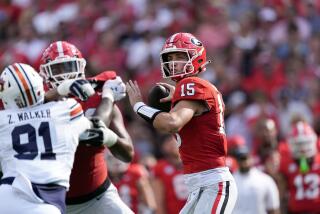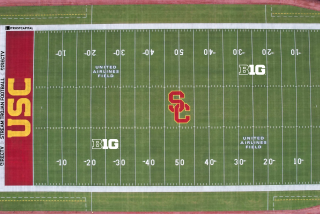Making the Grade Isn’t Academic
Big-time college sports -- focused for so long on football rankings and basketball tournament seedings -- will get a new set of numbers to ponder today.
For the first time, the NCAA will release a comprehensive “academic progress rate” report, an annual survey that rates every major college team in the nation, from the largest football squad to the smallest rowing crew, by how it performs in the classroom.
The numbers will eventually be used as part of a broad academic reform in which teams must satisfy minimum standards or face penalties that include loss of scholarships and banishment from postseason play.
The inaugural progress report, known as APR, represents a trial run because the NCAA will not begin handing out penalties until next year. Still, officials predict that more than 50% of Division I schools will have at least one team fall below the so-called “cutoff line,” and they warn athletic departments to take heed.
NCAA senior advisor Wally Renfro called it “a snake in the grass waiting to bite you.”
“If you are living life in the danger zone,” he said, “it is only a matter of time before you get into trouble.”
The NCAA has come under increasing scrutiny since 2001, when a respected watchdog group -- the Knight Foundation’s Commission on Intercollegiate Athletics -- decried a “widening chasm between higher education’s ideals and big-time college sports.”
Critics have recommended, for instance, that teams should have to graduate at least 50% of their athletes to be eligible for postseason play. Last football season, nearly half of the squads in bowl games failed to meet that standard.
Of the eight teams in the prestigious bowl championship series, only three -- USC, Michigan and Virginia Tech -- had graduation rates of 50% or higher.
“Listen, the Knight Commission has wanted there to be consequences [for poor academic performance] for a long time,” said Thomas Hearn, president of Wake Forest and the commission’s chairman. “We support what [the NCAA] is doing.”
But not everyone is confident the APR will help to bring change.
Ellen Staurowsky, a professor of sport management and media at Ithaca College in New York, says that as long as college sports equate to big money -- with multimillion-dollar television contracts and corporate sponsorships -- coaches and their athletic departments will be pressured to cut corners, if not cheat, to win.
“I don’t have a lot of confidence [the APR] will have a meaningful impact,” said Staurowsky, who belongs to an academic group that has pushed for athletic reform. “The NCAA needs to take a very hard look at the entire nature of college sports. Until such time as those kinds of things get cleaned up, if they can be cleaned up, than these other measures are what I would call public relations moves designed to protect the NCAA brand.”
It was the fall of 2002 when NCAA leaders, prodded by President Myles Brand, began passing a new round of academic legislation.
First came a change to the eligibility standard for incoming freshmen.
Critics had argued that requiring a minimum score on standardized tests was unfair to blacks and Latinos who have tended to score lower than other groups. The association instituted a sliding scale that relied more heavily on grade-point average while requiring high school students to take additional college-preparatory classes.
Next, the NCAA toughened the rules for athletes once they reach college. To remain eligible, scholarship players must complete 40% of the credits toward a degree by the end of their second year, 60% by the end of the third and 80% by the end of the fourth.
Finally, last April, officials proclaimed a “sea change” with the enactment of the APR and its penalties for poor performance. The program was intended to go beyond the traditional practice of punishing individual athletes, now holding teams and entire athletic departments accountable.
The APR formula works like this:
At the end of each academic period -- be it a semester or quarter -- each athlete is graded on two points. Did he or she get high enough grades to remain eligible for sports? Did he or she stay in school?
A basketball team with 10 players would have a maximum potential score of 20 points a semester, or 40 for the school year.
If two players fail their classes and drop out, the team gets 36 of 40 points for a .900 average or, as the NCAA calculates it, a score of 900.
The NCAA has set the cutoff line at 925, so the hypothetical team scoring 900 could face penalties.
If a team falls below 925 and one of its players leaves school, it loses that scholarship for the next academic year. Extremely low APRs could result in the loss of up to 10% of scholarships and additional recruiting restrictions.
As Renfro explained: “You’ll have a program that is going to have a very hard road coming back to prominence.”
Built into the new system is a significant incentive. In the past, if a player became academically ineligible, it behooved the team to cut him or her loose, freeing up that scholarship. Now, the team is better off keeping the player enrolled in classes, thereby scoring an extra point -- did the athlete stay in school? -- on its APR report.
“We want schools to retain those students,” said Kevin Lennon, an NCAA vice president. “That student has fallen off the academic wagon, but the institution says, ‘We want you to get well.’ ”
Soon, the NCAA will introduce an additional yardstick called the “graduation success rate,” or GSR. This will measure the percentage of athletes from a given team who graduate within six years.
The GSR resembles the U.S. government’s current measure of graduation rates, but with adjustments that coaches have clamored for.
At present, if an athlete transfers in from another university, his or her eventual graduation does not count toward the team’s percentage. Similarly, any athlete who transfers out or leaves school early to turn professional -- even with good grades -- counts as a dropout.
The graduation rate will give teams credit for anyone who transfers in or out in good academic standing. But the new program also carries stiff consequences for schools that do not graduate enough players.
The so-called “historically based penalties” include exclusion from postseason play and further loss of scholarships. Severe cases could even result in a school’s being expelled from the NCAA.
But these “historical” penalties will not kick in until the 2008-09 school year. In the meantime, the NCAA has some kinks to work out of the system.
The association is still wrestling with adjustments to the APR cutoff line of 925. For instance, losing two players would doom a small team, while barely making a dent in the score for an 85-man football squad.
Officials are also considering a waiver by which some schools -- such as urban and commuter campuses with lower overall graduation rates -- are not held to the same standards as, say, Stanford or Harvard.
“That’s a philosophical point that I don’t know if our membership has ever wrestled down,” Lennon said.
Whatever form the APR and GSR ultimately take, NCAA leaders hope that with today’s initial report, athletic programs will adopt a different view of the relationship between athletics and academics.
“The goal is not to crush a program,” Lennon said. “The goal is to change behavior.”
More to Read
Go beyond the scoreboard
Get the latest on L.A.'s teams in the daily Sports Report newsletter.
You may occasionally receive promotional content from the Los Angeles Times.











